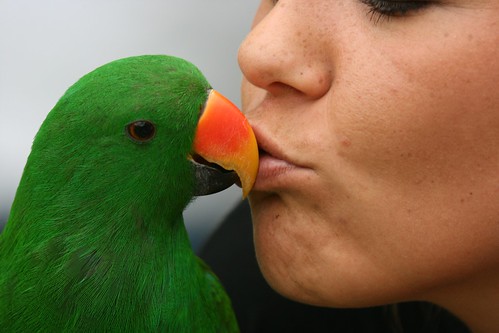Parrot Geriatrics
 Thursday, July 19, 2012 at 6:38
Thursday, July 19, 2012 at 6:38  Older parrots need special care and love!Parrots today have so many advantages when it comes to medical care and nutrition that many are entering middle age and their golden years in excellent health. With advancing age, what can we expect regarding the health of our pet birds? Many problems with geriatric birds can be directly attributed to nutritional issues. While malnutrition is a lot less prevalent these days due to advances in avian nutrition, we still see the occasional “seed junkie” that has resisted all attempts at conversion to a more balanced and varied diet. These pet birds are more likely to be suffering from vitamin-A deficiency and calcium deficiency.
Older parrots need special care and love!Parrots today have so many advantages when it comes to medical care and nutrition that many are entering middle age and their golden years in excellent health. With advancing age, what can we expect regarding the health of our pet birds? Many problems with geriatric birds can be directly attributed to nutritional issues. While malnutrition is a lot less prevalent these days due to advances in avian nutrition, we still see the occasional “seed junkie” that has resisted all attempts at conversion to a more balanced and varied diet. These pet birds are more likely to be suffering from vitamin-A deficiency and calcium deficiency.
Obesity due to a pet bird consuming a high-fat seed and nut diet or from a pet bird simply consuming more calories than it uses up in a day is common in many species of older birds, including quaker parrots, Amazons, rose-breasted cockatoos, cockatiels and budgies, to name a few. Before attempting any dietary conversion in a bird, it is imperative that the pet bird receive a clean bill of health from a qualified avian veterinarian, as the stress of changing the diet can precipitate a health crisis in a sub-clinically ill bird.
Arthritis In Pet Birds
Arthritis — technically inflammation of one or more joints — is common in older pet birds. This, too, can be related to obesity, as extra body weight puts abnormal stress and strain on joints, which can lead to joint pain and swelling. With the advances today in pharmacology, there is no reason for a bird to suffer needlessly due to pain from arthritis — or from many other conditions, for that matter. Several non-steroidal anti-inflammatories are available for use in birds.
Slower Pace
Older birds may play less and become less active, or in some cases (unfortunately) owners may spend less time interacting with their pet birds as the years go by, leading to a more sedentary lifestyle. In addition to the medical problems that may occur from a lowered activity level, older pet birds may become bored, which can lead to a duller mental state. People who are routinely challenged mentally by working crossword puzzles, reading or playing games tend to maintain better mental acuity than those who don’t. Similarly, I believe it is vital for older pet birds to receive consistent mental stimulation and challenges to remain in the best state of mind. A stimulating environment (toys, puzzles, interaction and visual stimulation) is just as important for older pet birds as is it for younger pet birds.
With the wonderful care that our pet birds are afforded today, we can expect many to live a long, healthy life. Appropriate veterinary care and diagnostics can help identify any problems as birds age, and your own avian vet can advise you as to the correct intervals for examinations and testing for geriatric avian patients.
Did You Know?
Unless absolutely necessary, it is best to avoid steroid use in our avian species due to their immunosuppressive tendencies, which can prove life-threatening. Steroids can also have other dangerous side-effects, as well.
Age-Related Conditions In Pet Birds
As pet birds age, their organ systems may begin to wear out or develop problems. Certain species are more prone to specific problems. For example, African grey parrots have been identified as having more atherosclerotic lesions inside of blood vessels than other species.
Diabetes, problems with blood glucose regulation, is more likely to occur in older, overweight birds. Cataracts, a progressive opacity of the lens (behind the iris) may occur in older birds of any species and may involve one or both eyes. Heart failure can develop in older birds, although since birds tend to be very athletic (flying is a remarkable feat of athleticism) their hearts tend to be quite strong. Renal failure is one of the more common problems in older birds, and an increase in water consumption and more urine in droppings can be indicators that the kidneys aren’t functioning at optimal capacity.
Older pet birds may have diminished immune system function, so they may be more susceptible to certain bacterial, fungal, protozoal or viral infections.
Older pet birds may develop tumors, which may involve any organ or system. Tumors can be benign or malignant (cancerous). Some species of birds, as they age, tend to develop benign fatty tumors, called lipomas. Lipomas are more commonly seen in overweight Amazon parrots, rose-breasted cockatoos and budgerigars (budgies). It seems that older pet budgies are more prone to tumors of the ovary, testicle or kidney, which may eventually put pressure on the sciatic nerve on the affected side, resulting in lameness of that foot or leg. Tumors found on the wing are often fibromas or fibrosarcomas and may need to be surgically removed, or in cases where the involvement is severe, amputation of the wing may be necessary.
 Pet care
Pet care 
